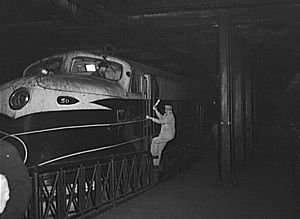EMC EA/EB: Difference between revisions
mNo edit summary |
No edit summary |
||
| Line 7: | Line 7: | ||
| builddate=May 16th, 1937–1938 |
| builddate=May 16th, 1937–1938 |
||
| builder=[[Electro-Motive Diesel|Electro-Motive Corporation]] (EMC) |
| builder=[[Electro-Motive Diesel|Electro-Motive Corporation]] (EMC) |
||
| operator=[[Baltimore and Ohio Railroad]], [[Alton]], [[Gulf Mobile and Ohio]] |
| operator=[[Baltimore and Ohio Railroad]], [[Alton]], [[Gulf, Mobile and Ohio]] |
||
| poweroutput={{convert|1800|hp|abbr=on|lk=in}} |
| poweroutput={{convert|1800|hp|abbr=on|lk=in}} |
||
| primemover = [[Winton Motor Carriage Company|Winton]] 201-A, 2 off |
| primemover = [[Winton Motor Carriage Company|Winton]] 201-A, 2 off |
||
Revision as of 07:59, 12 November 2016
| EMC EA/EB | |||||||||||||||
|---|---|---|---|---|---|---|---|---|---|---|---|---|---|---|---|
 B&O EA 56 at Chicago, Illinois, February 1943 | |||||||||||||||
| |||||||||||||||
| |||||||||||||||
| |||||||||||||||
| |||||||||||||||
The EMC EA/EB was an early passenger train-hauling diesel locomotive built in May 16, 1937 – 1938 by Electro-Motive Corporation of La Grange, Illinois for the Baltimore and Ohio Railroad.[1][page needed] They were the first model in a long line of passenger diesels of similar design known as EMD E-units. Each locomotive unit developed 1,800 horsepower (1,300 kW) from two 900 hp (670 kW) Winton 201-A diesel engines, driving the wheels through an electric transmission—the generator driven by each engine provided current for traction motors. The locomotives were of A1A-A1A wheel arrangement—two three-axle trucks of which only the outer two axles were powered. Six two-unit 3,600 hp (2,700 kW) locomotives were produced, each consisting of a lead cab-equipped EA A unit and a cabless booster EB B unit. They were numbered 51 through 56; the A units bore the bare number and the B units the number followed by 'X'.
Trains hauled
The six locomotives hauled some of the major named trains of the B&O; the Royal Blue, the Capitol Limited, the National Limited, and others. These trains were streamliners in appearance, but they were built largely of refurbished heavyweight passenger cars rebuilt with smooth sides, smooth rooflines, air conditioning, new interiors and modern appointments.
B&O 52 was sold to the Alton Railroad in 1940. This locomotive became a Gulf Mobile and Ohio unit in 1947.
Significance and influence
The EA/EB—along with the more-or-less simultaneous E1 for the Atchison, Topeka and Santa Fe Railway and the E2 for the Union Pacific Railroad, Chicago and North Western Railway and Southern Pacific Railroad—represented an important step in the evolution of the passenger diesel locomotive. While the EA, E1 and E2 were each built for a specific railroad, they were largely identical mechanically and were a step further away from the custom-built, integrated streamliner and towards mass-produced passenger locomotives—a step achieved with the E3, E4, E5, and E6, EMC's next models. These locomotives are definitely related in an evolutionary manner with all EMD's future passenger models.[according to whom?]
Styling
The EA/EB and E1 featured largely identical and innovative styling showing the influence of the Electro-Motive Corporation's new buyer General Motors. While mechanically they had much in common with previous, experimental EMC locomotives, GM understood the importance of looking new and exciting, not merely being technically innovative. This basic "slant nose" style was continued in the subsequent E3, E4, E5 and E6 models, while a more "bulldog nose" style was tried in the E2 and a style somewhere in between was used for the E7, E8 and E9, as well as the freight diesel cab units. It could fairly be said that the overall styling influenced passenger locomotives around the world.
Its initial design was protected under US Patent D106,918.[2]
Preservation
The first EA, #51, survives as a static exhibit at the Baltimore and Ohio Railroad Museum in Baltimore, Maryland.
References
Notes
- ^ Pinkepank 1973.
- ^ US patent D106918, Harold L. Hamilton, Richard M. Dilworth, Martin P Blomberg, Leland A. Knickerbocker, and Chris J. Klein, "Design for a Locomotive Body", issued 1937-11-09
Bibliography
- Lamb, J. Parker (2007). Evolution of the American Diesel Locomotive. Railroads Past and Present. Bloomington, Indiana: Indiana University Press. ISBN 978-0-253-34863-0.
- Marre, Louis A. (1995). Diesel Locomotives: The First 50 Years: A Guide to Diesels Built Before 1972. Railroad Reference Series. Waukesha, Wisconsin: Kalmbach Publishing. ISBN 978-0-89024-258-2.
- Pinkepank, Jerry A. (1973). The Second Diesel Spotter's Guide. Milwaukee, Wisconsin: Kalmbach Publishing. ISBN 978-0-89024-026-7.
- Schafer, Mike (1998). Vintage Diesel Locomotives. Enthusiast Color Series. Osceola, Wisconsin: MBI Publishing. ISBN 978-0-7603-0507-2.
- Solomon, Brian (2000). The American Diesel Locomotive. Osceola, Wisconsin: MBI Publishing Company. pp. 53–56, 63, 65, 67, 68, 70. ISBN 978-0-7603-0666-6.
- Solomon, Brian (2006). EMD Locomotives. St. Paul, Minnesota: Voyageur Press. ISBN 978-0-7603-2396-0.
- Solomon, Brian (2010). Vintage Diesel Power. Minneapolis, Minnesota: MBI Publishing. ISBN 978-0-7603-3795-0.
- Solomon, Brian (2011). Electro-Motive E-Units and F-Units: The Illustrated History of North America's Favorite Locomotives. Minneapolis, Minnesota: Voyageur Press. ISBN 978-0-7603-4007-3.
- Solomon, Brian (2012). North American Locomotives: A Railroad-by-Railroad Photohistory. Minneapolis, Minnesota: Voyageur Press. ISBN 978-0-7603-4370-8.
- Wilson, Jeff (2002). E Units: Electro-Motive's Classic Streamliners. Classic Trains / Golden Years of Railroading series. Waukesha, WI, USA: Kalmbach Publishing. ISBN 0890246068.
